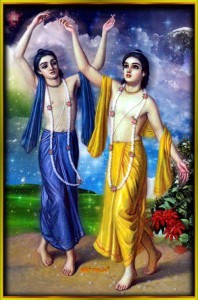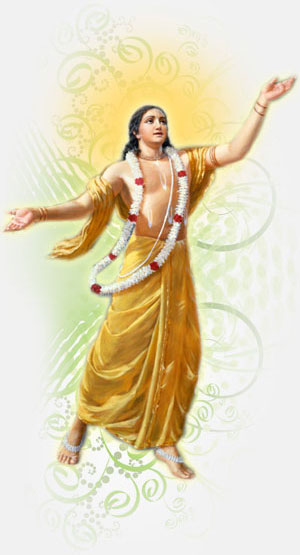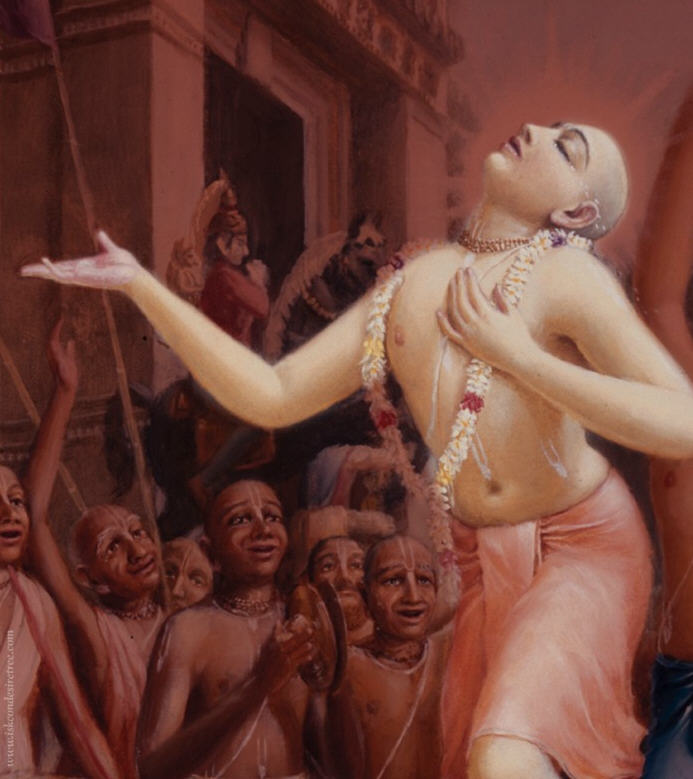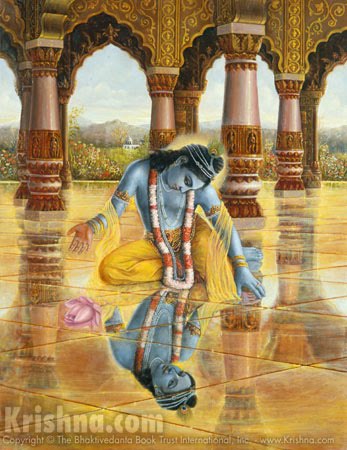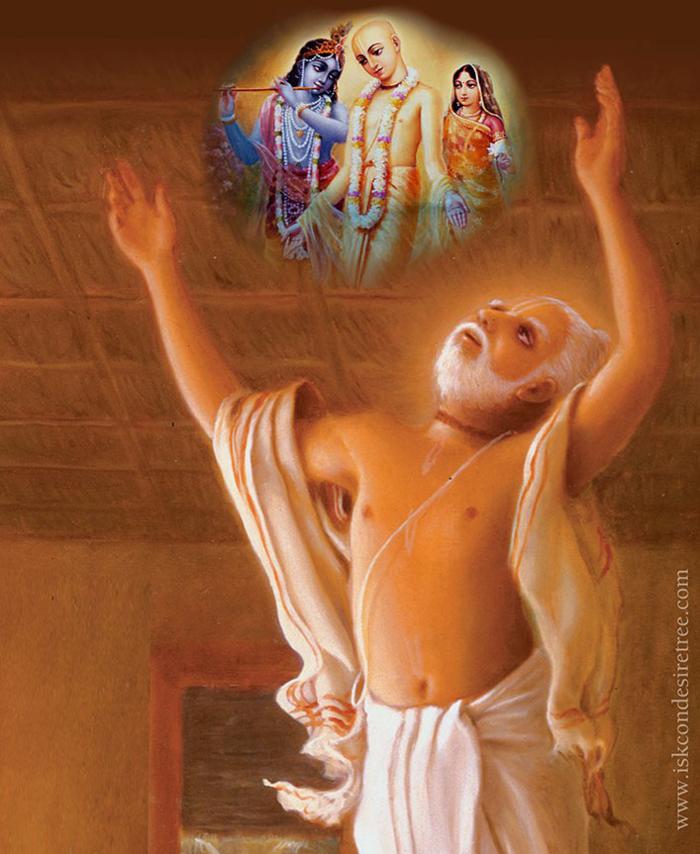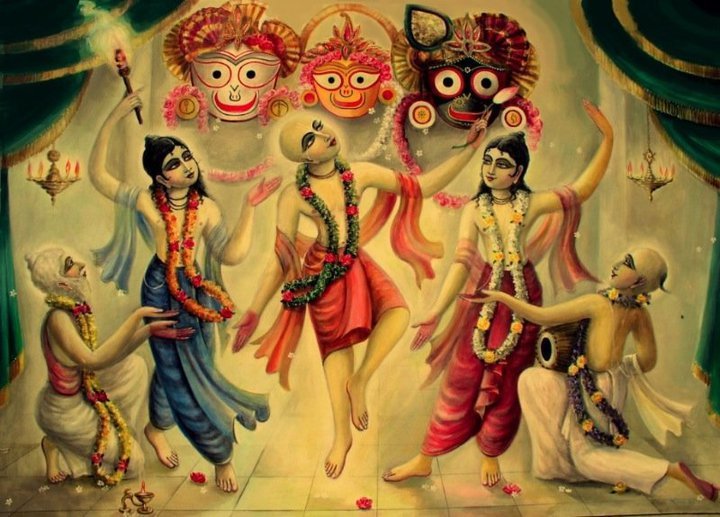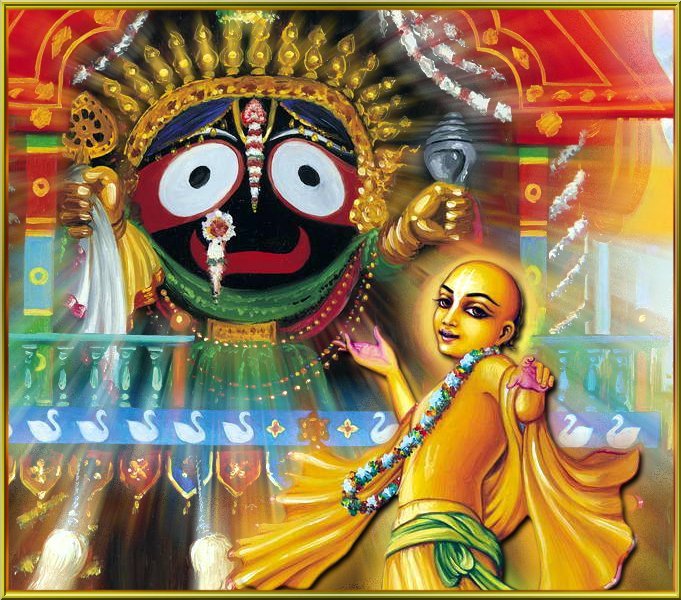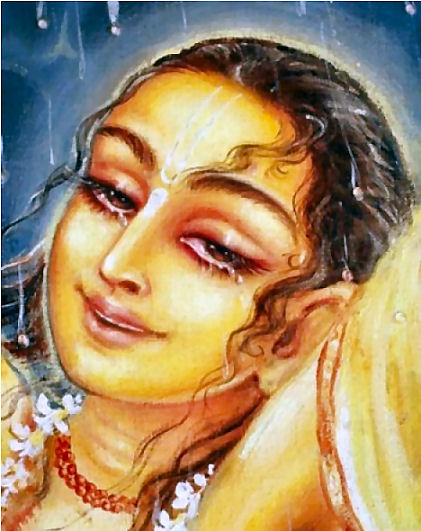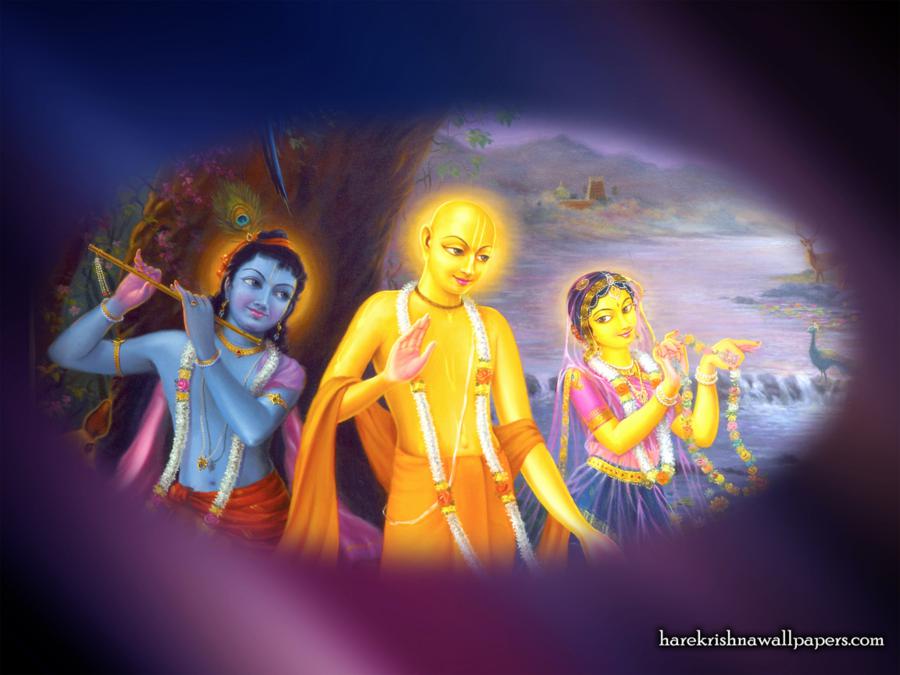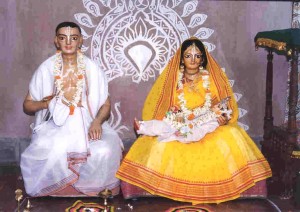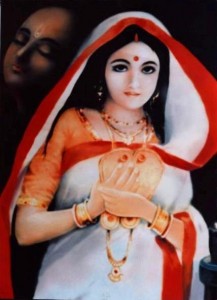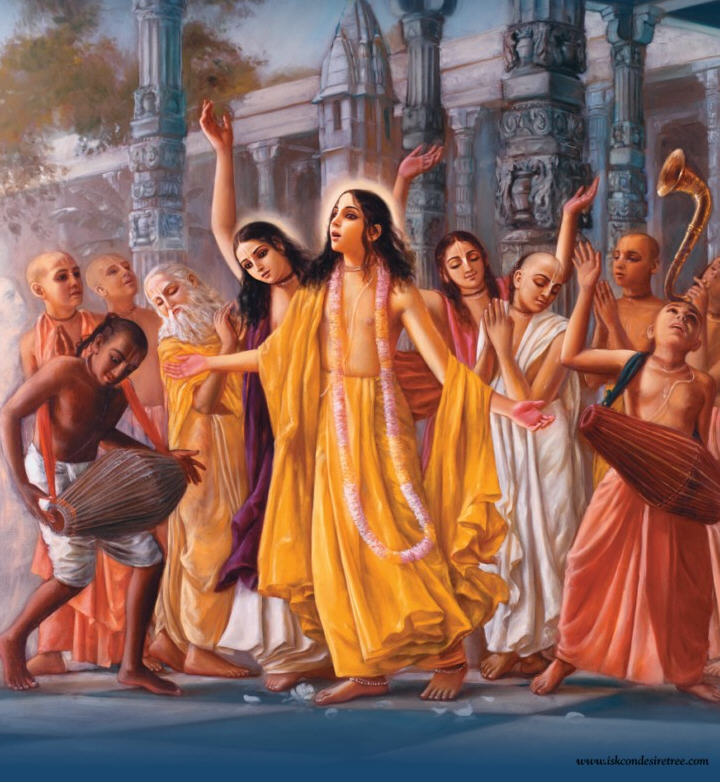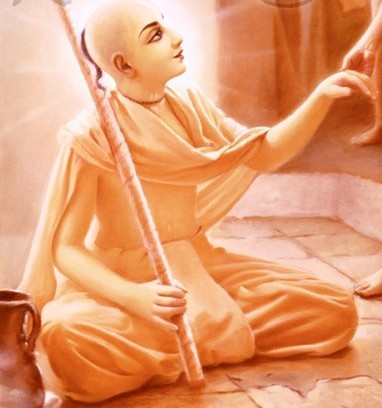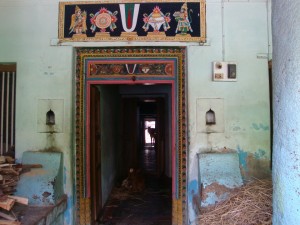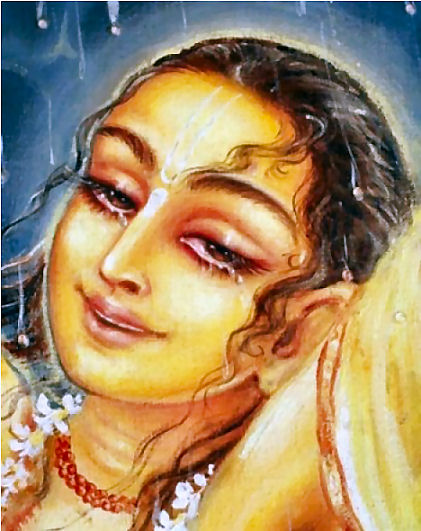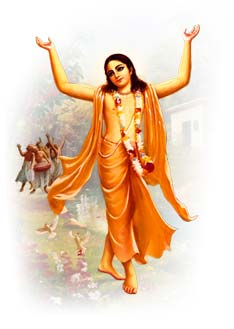
The Personality of Godhead (Sri Chaitanya Mahaprabhu) is brilliantly effulgence (like molten gold), and he is imperishable.
mahan-prabhur vai purusam sattvasyesu pravarttakam
surnimalam imam santisano jyotiravyam
The Personality of Godhead [Sri Chaitanya Mahaprabhu] is brilliantly effulgence [like molten gold], and he is imperishable. He is the Supreme Controller. He controls the mode of goodness and [through the performance of sankirtana] he bestows upon the living beings [the] spiritual intelligence [by which they can understand devotional service]. [In his acarya-lila, as a sannyasi] He is the source of spiritual purity and of liberation. He is therefore known as "Mahaprabhu." (Shvetasvatara Upanishad 2.12)
The Sruti establishes that The Supreme Lord will appear in a golden form as Sri Gauranga
4.2
yada pasyam pasyate rukma-varnam kartaram isam purusam brahma-yonim
tada vidyan punya-pape vidhuya nira-janam pramam samyam upaiti
When one realizes the golden form of that Lord [Sri Gauranga] who is the ultimate actor and the source of the Supreme Brahman, he attains the highest knowledge, transcends both pious and impious activities, becomes free from wordly bondage and gains entrance into the divine abode of the Lord. (Mundaka Upanisad 3.3)
The evidence of Srimad-Bhagavatam.
4.3
krishna-varnam tvisa-'krishnam sangopangastra-parsadam
yajnaim sankirtana-prayair-yajanti hi sumedhasam
In the age of Kali, Krishna appears in a golden form, [as Sri Gauranga] chanting the two syllables “Krish” “na”. He descends along with his weapons [The Holy Name of Krishna, Srimad-Bhagavatam, kirtana, and mahaprasada ], His limbs [His expansions and avataras such as Nityananda, Advaita, and His divine energies (saktis) such as Gadadhara, Svarupa Damodara, and Ramananda Raya], and eternal confidential associates [like Shrivasa Thakura, Haridasa Thakura, and other Devotees]. Those who are advanced in transcendental intelligence worship Him by performing sankirtana. (Srimad-Bhagavatam 11.5.32)
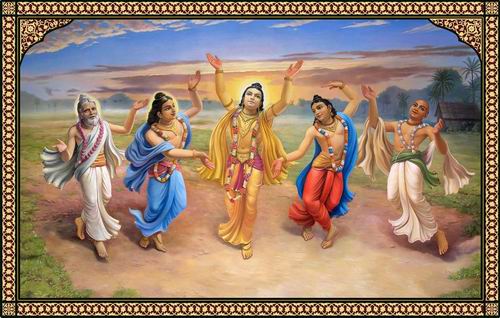
His limbs (His expansions and avataras such as Nityananda, Advaita, and His divine energies (saktis) such as Gadadhara, Svarupa Damodara, and Ramananda Raya), and eternal confidential associates (like Shrivasa Thakura, Haridasa Thakura, and other Devotees). Those who are advanced in transcendental intelligence worship Him by performing sankirtana. (Srimad-Bhagavatam 11.5.32) (In the image: Pancha Tattva).
4.4
"krishna" – ei dui varna sada ya-'ra mukhe
athava krishnake ti-ho varne nija sukhe
dehakantye haya ti-ho akrishna-varana
"akrishna" – varane kahe pita-varana
The two syllables "Krishna" are always in His mouth, or He always describes Krishna with great pleasure. These are two meanings of the words "Krishna-varna." Indeed, nothing but Krishna issues from His mouth. If someone tries to describe Him as being of blackish complexion, the next adjective, "tvisakrishnam" immediately restricts him. His complexion is certainly not blackish. Indeed, His not being blackish indicates that his complexion is golden. (Chaitanya Charitamrta-Adi 3.53,56)
4.5
asan varnastrayo'hyasya grhnato'nuyugam tanum
suklo-raktas-tatha-pita idanim krishnatam gatam
This boy, Krishna, has three other colors: white, red, and yellow, as he appears in different ages. Now, in this Dvapara-yuga, he has appeared in a transcendental blackish color. (Srimad-Bhagavatam 10.8.13)
4.6
sukla, rakta, krishna, pita – krame cari varna
cari varna dhari' "krishna" karena yugadharma
In the four ages, (yugas) Satya, Treta, Dvapara, and Kali, Krishna accepts four different colors: white, red, black, and yellow respectively. These are the colors of the different incarnations of Krishna in different milleniums. (Chaitanya Charitamrta Madhya 20.330)
4.7
itham nr-tiryag-rsi-deva-jhasavataraair
lokan vibhavayasi hamsi jagat-pratipan
dharmam mahapurusa pasi yuganuvrttam
channam kalau yad-abhavas tri-yugo 'tha sa tvam
[Prahlada said] O Krishna! In this way you appear in various incarnations: as a human being, an animal, a great saint, a demigod, a fish, or a tortoise. Thus maintaining the entire creation in different planetary systems. In this way, according to the age,You protect the principles of religion. But O, Mahaprabhu! In the age of Kali, [when you come to preach the Holy Name of Krishna, you do so as a Devotee and therefore] You do not assert Yourself as the Supreme Personality of Godhead. Because your Godhood is hidden in the age of Kali You therefore known as Triyuga, or the Lord who manifests his Supremacy in only three ages. [And for this reason many sastras have also kept your appearance in Kaliyuga a secret.] (Srimad-Bhagavatam 7.9.38)
The evidence of Mahabharata.
4.8
suvarna-varna hemango varangas-candanangadi
sannyasa-krcchamam santo nistha-santi-parayanam
[The following explanation of this verse is given by Srila Bhaktisiddhanta Saraswat and is based on the commentary by Baladeva Vidyabhushana on the Vishnu-sahasra-nama-stotram found in Mahabharata. These remarks are mentioned by A.C. Bhaktivedanta Swami in his translation of Srila Bhaktisiddhanta Saraswati Thakura’s anubhasya commentary on Chaitanya Charitamrta Adi 3.49.52)] When the Supreme Personality of Godhead Krishna appears as Sri Gauranga, in his early pastimes His complexion is gold (suvarna-varna ), his limbs are the color of molten white gold (hemanga), his body is extremely beautiful (varangas), and he is decorated with sandalwood pulp (candanangadi). [These four are the symptoms of His grhastha-lila.] Another meaning of the description of the Lord as having a golden hue is that Lord Chaitanya's personality is as fascinating as gold is attractive.
Sri Chaitanya accepts the sannyasa order of life (sannyasa-krt), and shows equanimity (sama) in different ways: by describing the mysteries of devotion to Sri Krishna, and by satisfying everyone by knowledge and attachment to Krishna. (santa). He is peaceful because He renounces all topics not related to the service of Krishna. His mind is always fixed on Krishna, and thus He is fixed (nistha ) in performing the great sacrifice of the Holy Name of Krishna. He silences the nondevotees and impersonalists who are opposed to the service of the Lord, by promoting the cause of devotion. Thus he distributes real peace. He is therefore an abode of the highest spiritual peace and devotion (mahabhava-parayana).(Mahabharata, Tadanadharma 149).
The evidence of the Puranas.
4.9
aham eva kvacid brahman sannyasnasramamnasritam
hari-bhaktim grahayami kalau papa-hatan-naran
[The Supreme Lord said to Sri Vyasadeva] O learned brahmanas, sometimes I accept the renounced order of life to induce the fallen people of the age of Kali to accept devotional service to the Lord. (Chaitanya Charitamrta Adi 3.81)
4.10
aham eva dvija-srestha nityam pracchana-vigraham
bhagavad-bhakta-rupena lokan raksami sarvada
O best of the brahmanas! My disguised form is eternal. In this way, with my own form hidden from ordinary sight, I take the form of a Devotee and appear among the people in general in order to establish and protect religious principles. (Adi Purana )
The version of the Goswamis.
4.11
antam krishnam bahir-gauram darsitangadi-vaibhavam
kalau sankirtanadyaim smam krishna-caitanyamnasritam
I take shelter of Sri Krishna Chaitanya Mahaprabhu, who is Krishna Himself, thinking of Himself. He is internally Krishna – blackish – but externally, he appears with the golden complexion [of Sri Radha]. In this age of Kali, Krishna appears as Krishna Chaitanya, simultaneously manifesting His eternal associates, opulences, expansions, and incarnations. In this way, he preaches the process of Krishna consciousness by performing sankirtana. (Tattva-Sandarbha 2)
Sri Gauranga is the fountainhead of all avataras.
4.12
sutiya acchinu ksira-sagara-bhitare
mora nidra bhanileka nadara hunkare
[While sitting on the altar of Vishnu in the house of Shrivasa, Sri Chaitanya Maharabhu said] Lying within ocean of milk, My transcendental slumber broke, as I awoke to hear the loud cries of my Devotees. Thus I [Lord Vishnu] have come [as Sri Cahitanya]. (Chaitanya Bhagavata Madhya 22.16).
4.13
sei krishna avatari vrajendra-kumara
apane caitanya-rupe kaila avatara
ata eva caitanya gosa-i paratattva sima
ta-re ksirodasayi kahi ki ta-ra mahima
sei ta bhaktera vakya nahe vyabhicari
sakala sambhave ta-'te ya-'te avatari
avatarira dehe saba avatarera sthiti
keho kona mata kahe yemama ya'ra mati

That same Lord Sri Krishna who is the fountainhead of all avataras is the son of the king of Vraja. He has descended personally as Sri Chaitanya Mahaprabhu. Therefore Sri Chaitanya Maharabhu is the supreme absolute truth.
That same Lord Sri Krishna who is the fountainhead of all avataras is the son of the king of Vraja. He has descended personally as Sri Chaitanya Mahaprabhu. Therefore Sri Chaitanya Maharabhu is the supreme absolute truth. To call Him Kshirodakshayi Vishnu does not add to His glory. But such words from the lips of a sincere Devotee cannot be false. All possibilities abide in Him because He is the primeval Lord. All other incarnations are potentially situated in the original body of the primeval Lord. Thus according to one's opinion one may address Him as any one of the avataras. (Chaitanya Charitamrta-Adi 2.109-112)
He is transcendental truth: He cannot be attained by wordly knowledge.
4.14
bhagavata-bharata-sastra agama purana
caitanya krishna-avatara prakata pramana
pratyakse dekhaha nana prakata prabhava
alaukika karma, alaukika anubhava
dekhiya na dekhe yata abhaktera gana
uluke na dekhe yena suryera kirana
Srimad-Bhagavatam, Mahabharata, the Puranas, and other Vedic literatures all give evidence to prove that Sri Chaitanya is the avatara or descent of Krishna Himself. One can also directly see Sri Chaitanya's manifest influence in His uncommon deeds and uncommon Krishna conscious realization. But faithless unbelievers do not see what is clearly evident, just as owls do not see the rays of the sun. (Chaitanya Charitamrta-Adi 3.83 – 85)
Sri Krishna Chaitanya Tattva: the Lord's sixfold nature.
4.15
sakala vaisnava suna kari' ekamana
caitanya-krsnera sastre yemata nirupana
krishna, gurudvaya, bhakta, avatara prakasa
sakti – ei chayarupe karena vilasa
I advise all my Vaishnava readers to read and hear with rapt attention this narration of the pastimes of Sri Krishna Chaitanya as inculcated in the revealed scriptures. Lord Krishna enjoys His pastimes by manifesting Himself (Krishna) as the spiritual masters (guru), His Devotees (bhakta), His diverse energies (sakti), His incarnations (avatara), and His full expansions (prakasa). (Chaitanya Charitamrta-Adi 1.31 – 32)
Sri Gauranga is the supreme truth.
4.16
yad advaitam brahmopanisadi tad-apy-asya tanubha
ya atmantaryami purusa iti so'syamsa-vibhavam
sad-aisvaryaim purno ya iha bhagavan sa svayam-ayam
na caitayanyat krishnaj-jagati paratattvam param iha
What the Upanisads describe as the impersonal absolute (brahman) is but the effulgence of His (Sri Chaitanya's) body. The Lord who is known as the Supersoul (paramatma) is but his localized expansion. He is the Supreme Personality of Godhead, Krishna Himself, (bhagavan), full in six opulences. He is the Absolute Truth, one without a second. There is no truth superior to Sri Krishna Chaitanya Mahaprabhu. (Chaitanya Charitamrta-Adi 1.3)
Sri Chaitanya Mahaprabhu is the jagad-guru.
4.17
caudda-bhuvanera guru caitanya gosa-i
ta-'ra guru anya, ei kona sastre nai
Sri Chaitanya Mahaprabhu is the jagad-guru, the spiritual master of the fourteen worlds. No other guru can compare with Him. (Chaitanya Charitamrta-Adi 12.16)
Sri Gauranga is the best of all.
4.18
saundarye kama-kotim sakala-jana samahladane candrakotir
vatsalye matrkotis tridasavitapinam kotir audarya-sare
gambhirye 'mbodhi-kotir madhurimani sudha-ksira-madvhika-kotir
gaurodevam sa jiyat pranaya-rasapade darsitascarya-kotim
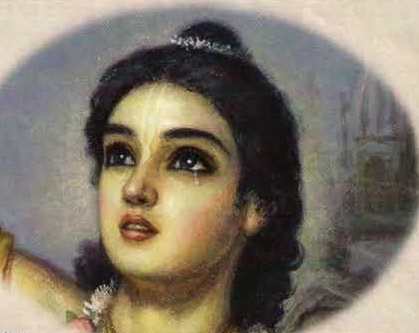
Sri Chaitanya Mahaprabhu is lovelier than millions of cupids, mellower than millions of moons, dearer than millions of mothers, kinder than millions of wish-fulfilling trees, deeper than millions of oceans, and sweeter than millions of nectarine drinks. All glories to Sri Chaitanya Mahaprabhu, the Supreme Lord who displays millions of amazing sentiments of madhurya-bhakti, the most exalted mellow of pure love of Godhead. (Chaitanya-Chandamrta 101)
Sri Chaitanya Mahaprabhu is lovelier than millions of cupids, mellower than millions of moons, dearer than millions of mothers, kinder than millions of wish-fulfilling trees, deeper than millions of oceans, and sweeter than millions of nectarine drinks. All glories to Sri Chaitanya Mahaprabhu, the Supreme Lord who displays millions of amazing sentiments of madhurya-bhakti, the most exalted mellow of pure love of Godhead. (Chaitanya-Chandamrta 101)
Sri Gauranga's principle, name, form, qualities and pastimes: (tattva,nama,rupa,guna,lila)
4.19
namo maha-vadanyaya krishna-prema-pradaya te
krishnaya krishna-caitanya-namne gaura-tvise namam
His nature (tattva) is that He is Krishna Himself. His name (nama) is "Krishna Chaitanya." His form (rupa) is golden. His quality (guna) is that He is the most magnanimous of all Personalities of Godhead. His pastime (lila) is to distribute the highest love of Godhead: Krishna-prema. I offer my obeisances unto that most generous Lord, Sri Krishna Chaitanya Mahaprabhu. (Chaitanya Charitamrta-Madhya 19.53)
Sri Gauranga delivers everyone by distributing the Holy Name of Krishna.
4.20
sankirtana-pravartaka sri krishna caitanya
sanirtana-yaj-e ta-'re bhaje sei dhanya
sei ta' sumedha ara kubuddhi samsara
sarva-yajna haite krishna-nama sara
Sri Chaitanya Mahaprabhu inaugurated the sankirtana movement. One who worships Him through sankirtana is fortunate indeed. Such a person is truly intelligent, whereas others, who have but a poor fund of knowledge, must endure the cycle of repeated birth and death. Of all sacrificial performances, the chanting of the Lord's Holy Name is the most sublime. (Chaitanya Charitamrta-Adi 3.76 – 77)
Sri Gauranga is the giver of Krishna-prema.
4.21
uchalila premavanya caudike vedaya
stri-vrddha-balaka-yuva sakali dubaya
sajjana, durjana, pangu, jata andhagana
premavanyaya dubaila jagatera jana
The flood of love of Godhead distributed by Sri Chaitanya Mahaprabhu swelled in all directions and thus, young men, old men, women, and children were all immersed in that inundation. The Krishna consciousness movement begun by Sri Chaitanya Mahaprabhu will inundate the entire world and drown everyone, whether one be a gentleman or rogue, or even lame, invalid, or blind. (Chaitanya Charitamrta-Adi 7.25,26)
4.22
patrapatra-vicara nahi, nahi sthanasthana
yei ya-ha paya, ta-ha kare prema dana
lutiya khaiya diya bandara prema sataguna vade
In distributing love of Godhead, Sri Chaitanya Mahaprabhu and his associates did not consider who was fit and who was unfit; nor where such distribution should or should not take place. They may no such conditions. Rather, wherever they got the opportunity, the members of the pancha-tattva distributed love of Godhead. Although the members of the pancha-tattva plundered the storehouse of love of Godhead and ate and distributed its contents, there was no scarcity, for this wonderful storehouse is so complete that as the love is distributed, the supply increases hundreds of times. (Chaitanya Charitamrta-Adi 7.23,24)
Who would cheat themselves out of love of godhead?
4.23
mayavadi karma-nistha kutarkikagana
nindaka pasandi yata paduya adhama
sei saba mahadaksa dhaina palaila
sei vanya ta' sabare chuite narila
The impersonalists, fruitive workers, false logicians, blasphemers, nondevotees, and lowest among the student community are very expert in avoiding the Krishna consciousness movement. Therefore the mercy of Sri Chaitanya Mahaprabhu, in the form of this Krishna consciousness movement, cannot reach them. (Chaitanya Charitamrta-Adi 7.29,30)
By the mercy of Sri Gauranga one can know the proper conclusions of scripture.
4.24
sri caitanya prabhum vande balo'pi yad-anugrahat
taren-nanamata-grahavyaptam siddhanta-sagaram
I offer my obeisances unto Sri Chaitanya Mahaprabhu, by whose mercy even an ignorant child can swim across the ocean of conclusive truth which is filled with the crocodiles of various theories. (Chaitanya Charitamrta-Adi 2.1)
4.25
hrdaye dharaye ye caitanya nityananda
ei saba siddhante sei pai be ananda
ei saba siddhanta haya amrera pallava
bhaktagana usthrera ithe nahaya pravesa
tabe citte haya mora ananda visesa
(Krishna Dasa Kaviraja Goswami says) Anyone who has captured Sri Chaitanya Mahaprabhu and Nityananda Prabhu within his heart will become blissful by hearing all these transcendental conclusions. All these conclusions are like the newly grown twigs of a mango tree: they are always pleasing to the Devotees, who in this way resemble cuckoo birds. The camel-like nondevotees, however, cannot enter into these topics, and therefore there is special jubilation within my heart. (Chaitanya Charitamrta-Adi 4.233,235)
Sri Gauranga's preaching pastimes.
4.26
sannyasi panditaganera karite garvanasa
nica-sudra-dvara kare dharmera prakasa
bhakti-tattva prema kahe raye kari vakta
apani pradyumna-misra saha haya srota
haridasa-dvara nama-mahatmya-prakasa
sanatana-dvara bhaktisiddhanta-vilasa
sri rupa-dvara vrajer rasa-prema-lila
ke kahite pare gambhira caitanyera khela
To vanquish the false pride of so-called sannyasis and learned scholars, he spread real religious principles, even through a sudra, or lowborn person. Sri Chaitanya Mahaprabhu preached about devotional service, ecstatic love, and the absolute truth by making Ramananda Raya, a grhastha born in a low family the speaker. Then Mahaprabhu Himself, the exalted brahmana sannyasi, and Pradyumna Mishra, the purified brahmana, both became the hearers of Ramananda Raya. Sri Chaitanya Mahaprabhu exhibited the glories of the Holy Name of the Lord through Haridasa Thakura, who was born in a Muslim family, and similarly He exhibited the essence of devotional service through Sanatana Goswami, who had almost been converted into a Muslim. The Lord also fully exhibited the ecstatic love and transcendental pastimes of Vrindavana through Srila Rupa Goswami. Considering all this, who can understand the deep plans of Sri Chaitanya Mahaprabhu? (Chaitanya Charitamrta-Antya 5.84 – 87)
4.27
vraje ye vihare purve krishna-balarama
koti candra-surya jini' do-hara nija dhama
sei dui jagatere haiya sadaya
gaudades purva saile karila udaya
sri krishna caitanya ara prabhu nityananda
ya-hara prakase sarva jagata ananda
surya-candra hare yaicche saba andhakara
bastu prakasiya kare dharmera pracara
ei mata dui bhai jivera ajnana
tamonasa kari' kare vastu-tattva dana
suryacandra bahirera tamo se vinase
bahirvastu ghatapata adi se prakase
dui bhai hrdayera ksali' andhakara
dui bhagavata-sane karan saksatkara
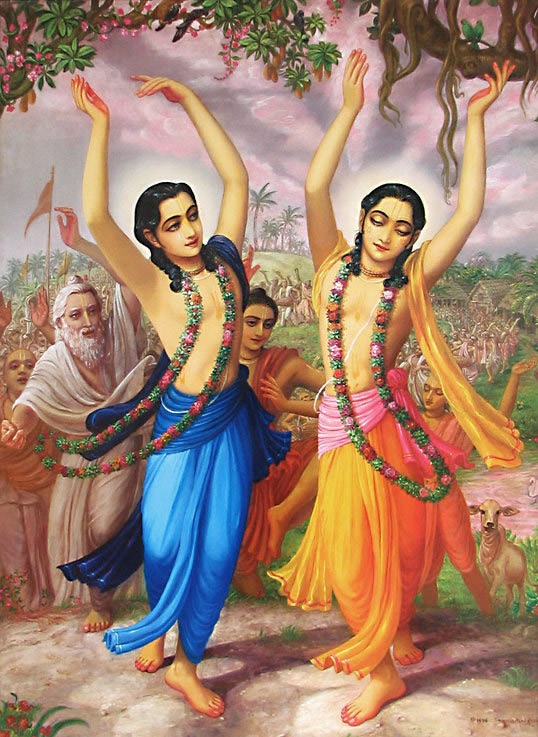
...The appearance of Sri Chaitanya and Nityananda has surcharged the world with happiness. As the sun and moon drive away darkness by their apperance and reveal the nature of everything, these two brothers dissipate the darkness of the living beings' ignorance and enlighten them with knowledge of the Absolute Truth. (In the image: Lord Sri Nityananda in the left and Lord Sri Krishna Chaitanya in the right).
Sri Krishna and Balarama, the Personalities of Godhead who formerly appeared in Vrindavana and who were millions of times more effulgent than the sun and moon have arisen over the eastern horizon of Gauda-desa, being compassionate for the fallen state of the world. The appearance of Sri Chaitanya and Nityananda has surcharged the world with happiness. As the sun and moon drive away darkness by their apperance and reveal the nature of everything, these two brothers dissipate the darkness of the living beings' ignorance and enlighten them with knowledge of the Absolute Truth. By the grace of Sri Chaitanya and Nityananda, all darkness is removed, and the truth is brought to light. The sun and moon dissipate the darkness of the external world and thus reveal material reality. But these two brothers dissipate the darkness of the inner core of the heart, and thus help one to meet the two kinds of bhagavatas, [Srimad-Bhagavatam and the pure Devotee.] (Chaitanya Charitamrta-Adi 1.85 – 99)
Sri Gauranga's example and precept.
4.28
hare-krsnetucchaim sphurita-rasano namaganana-
krta-granthi-sreni-subhaga-kati-sutrojjvala-karam
visalakso dirghargala-yugala-khela-cita-bhujam
sa caitanyam kim me punarapi drsoryasati padam
Sri Chaitanya Mahaprabhu chants the Hare Krishna mantra in a loud voice. The Holy Name dances on his tongue as he counts his number of recitations with His effulgent hands. His eyes are large, and His long arms, which bend as He performs his pastimes, reach down to His knees. When will he again become visible before me? (Stava-mala verse 5 – Sri Rupa Goswami)
Sri Gauranga's principle and ultimate goals.
4.29
ei mata caitanya-krishna purna bhagavan
yuga-dharma-pravartana nahe ta-'ra kama
kona karane yabe haila avatare mana
yugadharma kala haila se kale milana
dui hetu avatari' laina bhaktagana
apane asvade prema-nama-sankirtana
sei dvare acandale kirtana-sa-care
ei mata bhakta-bhava kari' angikara
apani acari' bhakti karila pracara
[Just as Sri Krishna really appeared in order to manifest His Vrindavana pastimes whereas his supression of demons was incidental,] in the same way, for Sri Chaitanya Mahaprabhu, promulgating the dharma for the age is an incidental reason for his appearance. When the Lord desired to appear for another reason, the time for promulgating the religion of the age also arose. Thus with two intentions, the Lord appeared with His Devotees and tasted the nectar of prema with the congregational chanting of the Holy Name. Thus he spread kirtana even among untouchables. He wove a wreath of the Holy Name and prema with which he garlanded the entire world. In this way, assuming the sentiment of a Devotee, He preached devotional service while practicing it Himself. (Chaitanya Charitamrta-Adi 4.37 – 41)
Sri Gauranga is like a lion.
4.30
caitanya-simhera nabadipe avatara
simha-griva simhaviraya simhera hunkara
sei simha vasuk jivera hrdaya-kandare
kalmasa-dviradanasa ya-jara hunkare
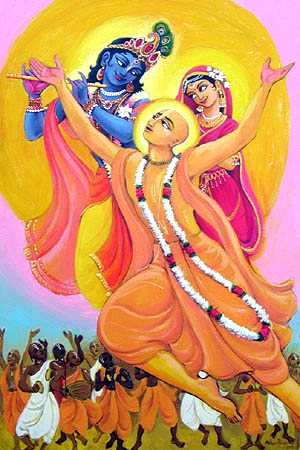
Thus the lionlike Sri Chaitanya Mahaprabhu has appeared in Navadwipa-dhama. He has the shoulders of a lion, the powers of a lion, and the loud voice of a lion. May that lion be seated in the core of the heart of every living being. Thus with His resounding roar, may he drive away one's elephantine vices. (Chaitanya Charitamrta-Adi 3.30 - 31)
Thus the lionlike Sri Chaitanya Mahaprabhu has appeared in Navadwipa-dhama. He has the shoulders of a lion, the powers of a lion, and the loud voice of a lion. May that lion be seated in the core of the heart of every living being. Thus with His resounding roar, may he drive away one's elephantine vices. (Chaitanya Charitamrta-Adi 3.30 – 31)
Sri Gauranga's external reasons for appearing.
4.31
anarpitacarim cirat karunayavatirnam kalau
samarpayitum-unnatojjvala-rasam sva-bhakti-sriyam
harim purata-sundara-dyuti-kadamba-sandipitam
sada hrdaya-kandare sphuratu vam sacinandanam
May that Lord who is known as the son of Srimati Sachidevi be transcendentally situated in the inner-most chambers of your heart. Resplendent with the radiance of molten gold, he has appeared in the age of Kali by His causeless mercy to bestow what no incarnation ever offered before: the most sublime and radiant spiritual knowledge of the mellow taste of his service. (Chaitanya Charitamrta-Adi 1.4, Vidagdha-Madhava 1.2)
Sri Gauranga's ultimate and confidential reason for appearing
4.32
sri radhayam pranaya-mahima kidrso vanayaiva-
svadyo yenadbhuta-madhurima kidrso va madiyam
saukhya-casya madanubhavatam kidrsam veti lobhat-
tad-bhavadyam samajani saci-garbha-sindhau harindum
Desiring to understand the glory of Srimati Raharani's love, the wonderful qualities in Him that She alone relishes through Her love, and the happiness She feels when She realizes the sweetness of His love, The Supreme Lord Hari, richly endowed with Her emotions, appears from the womb of Srimati Sachidevi as the moon appears from the ocean. (Chaitanya Charitamrta-Adi 1.6)
Internally he has the mood of Sri Radha, externally he preaches the Holy Name.
4.33
sei radha-bhava laina caitanya-avatara
yuga-dharma nama-prema kaila paracara
Sri Chaitanya Mahaprabhu appeared with the sentiments of Sri Radha. He preached the dharma of this age, the chanting of the Holy Name of Sri Krishna, and pure love of Godhead (Krishna-prema). (Chaitanya Charitamrta-Adi 4.220)
The pastimes of Sri Gauranga are eternal.
4.34
adyapiha caitanya ei saba lila kare
ya'ra bhagye thake se dekhaye nirantare
As yet, no one can completely see the opulences of all the pastimes performed by Sri Chaitanya Mahaprabhu, because they are without limit in time and space. They are unlimited and eternal. (Chaitanya Bhagavata Madhya 23.513)
Materialistic and demonic persons are envious of Sri Gauranga.
4.35
purve yena jarasandha adi rajagana
veda-dharma kari' kare visnura pujana
krishna nahi mane ta'te daitya kari' mannbsp/strongnbsp; ;Sri G/strongaurangai caitanya/strong na manile taiche daitya ta're jani
hena krpamaya caitanya na bhaje yei jana
sarvottama haile ta're asure ganana
Formerly, even kings like Jarasandha strictly followed the Vedic rituals, thus worshiping Lord Vishnu. One who does not accept Krishna as the Supreme Personality of Godhead is certainly a demon. Similarly, one who does not accept Sri Chaitanya Mahaprabhu as Krishna, the same Supreme Lord, is also to be considered a demon. One who does not show respect unto this merciful Lord Sri Chaitanya Mahaprabhu or does not worship Him should be considered a demon, even if that person is very "exalted" in human society. (Chaitanya Charitamrta-Adi 8.8,9,12)
Sri Gauranga in his acarya-lila is not the enjoyer of the rasa dance ("Gauranga-nagari")
4.36
ei mata capalya karena saba sane
sabe strimara nadekhena drsthikone
"stri" hena naa prabhu ei avatare
sravane o na karila – vidita samsare
ata eva yata maha-mahima sakale
"gauranga nagara" hena staqva nahi bale
The Lord was apt to indulge in such indiscrimate merciful behavior towards all, except that he never looked at a women, even by a sidelong glance. During this avatara, it is known to all the world that the Lord did not even allow the name of a women to enter his ear. Therefore, those who are His real Devotees never address Sri Gauranga as "Gauranga-nagari" or the enjoyer of women. Although all forms of praise are applicable to the Lord, the wise sing only what is in accordance with His nature. (Chaitanya Bhagavata Adi 15. 28 – 31)
The glories of the mercy of Sri Gauranga and Nityananda.
4.37
caitanya nityanande nahi ei' saba vicara
nama laite prema dena, bahe asrudhara
svatantra-isvara prabhu atyanta udara
ta-'re na bhajile kabhu nahaya nistara
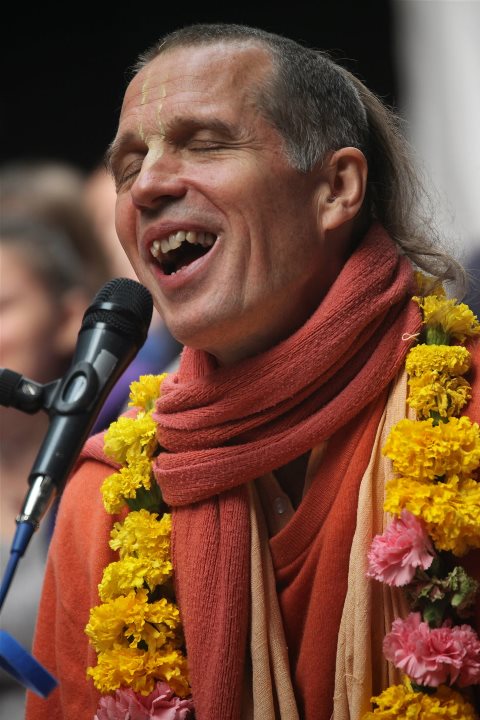
If one only chants with some slight faith the Holy Names of Sri Chaitanya Mahaprabhu and Nityananda, very quickly he is cleansed of all offenses. Thus, as soon as he chants the Hare Krishna mantra, he feels the ecstasy of love of Godhead...(In the image: His Holiness Sachinandana Swami, Kirtan Mela, Germany).
If one only chants with some slight faith the Holy Names of Sri Chaitanya Mahaprabhu and Nityananda, very quickly he is cleansed of all offenses. Thus, as soon as he chants the Hare Krishna mantra, he feels the ecstasy of love of Godhead. Sri Chaitanya Mahaprabhu, the independent Supreme Personality of Godhead is greatly magnanimous. Unless one worships Him, one can never be liberated. (Chaitanya Charitamrta-Adi 8.31-32)
The unfortunate position of those who cheat themselves out of Sri Gauranga's mercy.
4.38
caitan sajjana, durjana, Gauranga-nagariangu, jata andhaganayavatare bahe premarta-vanya
saba jiva preme bhase, prthivi haila dhanya
ei-vanyaya ye na bhase, sei jiva – chara
koti kalpe tabe ta'ra nahika nistara
There is now a flood of the eternal nectar of love of Godhead, because of the incarnation of Sri Caitanya Mahaprabhu. All living entities are floating in that flood. The entire world is now thankful to the Lord. Anyone who does not float in this inundation is most condemned. Such a person cannot be delivered for millions of lifetimes of Lord Brahma. (Caitanya Caritamrta-Antya 3.252-253)
4.39
avatara sara, gaura-avatara
kena na bhajili ta're
kari' nire vasa, gela na piyasa,
apana karama phere
kantakera taru, (sri) gauranga amara,
tahare bhavili vise
saurabhera ase, palasa su-kili,
nasate pasila kita
iksudanda bhavi' katha cusili,
kemane paibi mith
Sri Krishna and Balarama, the Personalities of Godhead who formerly appeared in Vrindavana and who were millions of times more effulgent than the sun and moon have arisen over the eastern horizon of Gauda-desa, being compassionate for the fallen state of the world. The appearance of Sri Chaitanya and Nityananda has surcharged the world with happiness. As the sun and moon drive away darkness by their apperance and reveal the nature of everything, these two brothers dissipate the darkness of the living beings.
te avatari gambhirye gauranga nagarag
hara baliya, galaya parili,
samana-kinkara-sapa
sitala baliya aguna pohali,
paili bajara-tapa
samsara bhajili, (sri) gauranga bhulili,
na sunili sadhura katha
iha-para-kala, du'kala khoyali,
khaili apana matha
Sri Gauranga Mahaprabhu is the essence of all avataras. Why didn't I worship Him? It is as if I was surrounded by water and dying of thirst but I denied myself a drink. I chewed the thorns on the tree of worldly life and took the blood that flowed through my mouth to be nectar. When I was offered the nectarine fruits of love of Godhead distributed by Sri Gauranga, however, I turned them away, thinking them to be poison. Wishing to smell perfume I sniffed at what I thought was the fragrant flower of material enjoyment. Alas, that flower was odorless, like the palasa flower. And when I tried to sniff its illusory aroma, a bee flew up my nose and stung me. Thinking material life to be as sweet as sugarcane, I tried to taste its nectar. Instead, as I sucked, I found it juiceless and dry. In this way, I found that all my attempts at enjoyment proved false. In this way, all my attempts at enjoyment proved false.
Admitting defeat, wasted and worn out, I await the snake of death. Declaring it to be cool and soothing, I have embraced the fire of material life, only to suffer intense miseries, as if struck by lightning. Worshiping family and material life I forgot Gauranga and didn't listen to the words of the saints. Now, in my final days I realize that I am twice dead, for not only am I casting off this mortal body, but I am dead while living, having wasted my life in material indulgence (Mahajana-giti).
Sri Gauranga appears in the form of His Holy Name and as His Deity
4.40
ara dui janma ei sankirtanarambhe
haiba tomara putra ami avilambe
mora arca-murti mata, tumi se dharani
jihvarupa tumi mata, namera janani
ei dui janma mora sankirtanarambhe
dui tha-i tora putra avilambe
[Sri Chaitanya told Sachi] Birth after birth you are my mother. Again, in this birth, I have come to begin the sankirtana movement, and so I have become your son. My appearance in this world is twofold: I appear as the archa-murti, the Deity form of the Lord, and as the Holy Name. In this way I appear upon the tongue in the form of sound, and as the Deity made from the elements drawn from earth. In both of these forms I am worshiped, and in these two features I have appeared in order to spread the sankirtana movement. (Chaitanya-Bhagavata Madhya 27.47)
The teachings of Sri Gauranga in a nutshell.
4.41
aradhyo bhagavan brajesa-tanayas-tad-dhama vrndavanam
ramya kacid-upasana vraja-vadhu-vargena ya kalpita
srimad-bhagavatam pramanam-amalam prema pumartho mahan
sri caitanya mahaprabhor-matam-idam tatradaro nam param
It is the conclusive opinion of Sri Chaitanya Mahaprabhu that: Sri Krishna, who is Vrajendra-nandana, the son of the king of Vraja, is the Supreme Personality of Godhead Himself, the topmost worshipable Deity; Vrindavan-dhama which is an expansion of Sri Krishna and is nondifferent from Him is the highest worshipable abode; The Gopis of Vrindavana are the highest example of the worship of Sri Krishna Srimad-Bhagavatam is the spotless evidence for knowing the absolute truth; Krishna-prema is the fifth and highest goal of life. These are the teachings of Sri Chaitanya in a nutshell. (Vishvanatha Chakravarti Thakura)
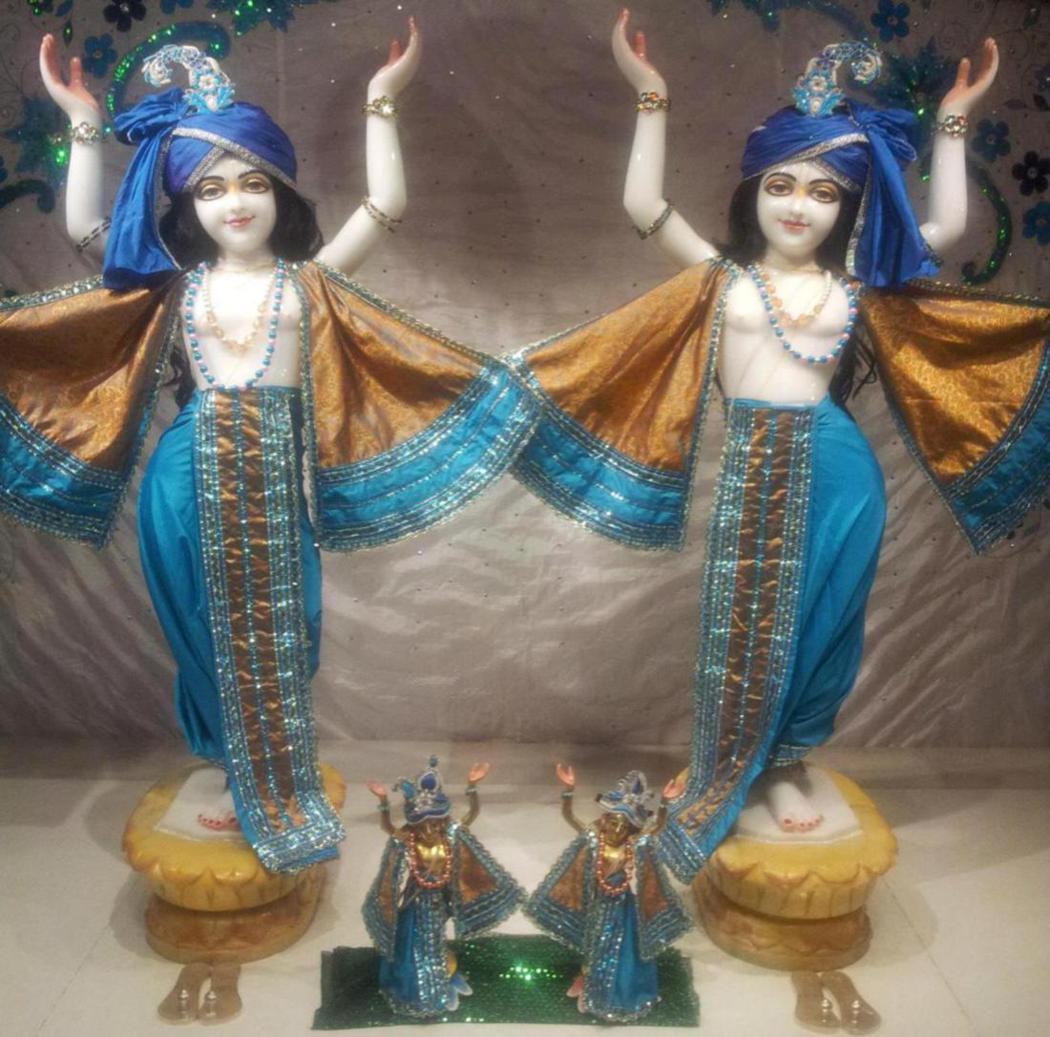
My appearance in this world is twofold: I appear as the archa-murti, the Deity form of the Lord, and as the Holy Name. In this way I appear upon the tongue in the form of sound, and as the Deity made from the elements drawn from earth. In both of these forms I am worshiped, and in these two features I have appeared in order to spread the sankirtana movement. (Chaitanya-Bhagavata Madhya 27.47) (In the image: Deities of Sri Sri Gaura Nitay, ISKCON Temple Chennai, Tamil Nadu).


